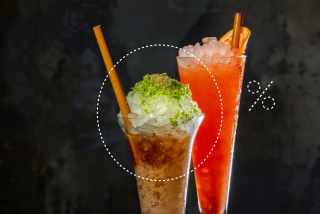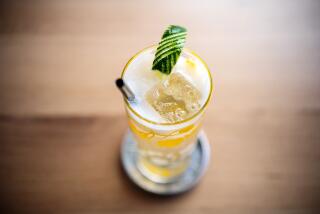Perfecting the art of the cocktail
RIGHT now, we’re in a golden age of American cocktails. More and more, bartenders at the best lounges and bars are offering lists of aperitifs, small-plates drinks and after-dinner drinks that sparkle with sophistication and creativity. And the cocktails created by some of the mixologists involved in the Museum of the American Cocktail are among the best. One frequently cited jumping-off point for even these most modern of cocktails is the classics.
“I really believe that every new drink is based on a classic,” says Tony Abou-Ganim, whose upcoming book is “The Modern Mixologist,” and who is currently touring the country offering cocktail seminars. “What I do is contemporary classics, which means I’m utilizing all the products, juices, purées, fruits and so forth that we have available today, but the foundation for my cocktails is steeped in the classics.
“If you don’t understand the classics, it’s tough to understand what makes a great cocktail. It comes down to balance, just like cooking.”
Abou-Ganim’s seemingly cutting-edge Brandy Crusta 21, for example, was developed after a classic recipe he found when researching 19th century recipes. A vital ingredient is maraschino liqueur, which Abou-Ganim had never seen at the time, although he knew it existed. After obtaining and testing several maraschino liqueurs for the Bellagio resort drink menu he was developing, he selected Maraschino Luxardo, made in Italy since 1851 but not widely available in the U.S.
On the other hand, Jacques Bezuidenhout, bar manager at Tres Agaves in San Francisco, points out that his La Perla cocktail is not based on a classic, but is “in a classic style” because it is made with all spirits and has just three ingredients. Before Prohibition, he notes, most cocktails were all spirits and fairly simple.
Reviving classics was a challenge in the late ‘80s when Dale DeGroff, president of the Museum of the American Cocktail, was in the early days of his career as a bartender under legendary New York restaurateur Joseph Baum (Four Seasons, Windows on the World, Rainbow Room).
“Joe inspired me — no, he demanded — a fresh bar: classic style, no mixes. At the time, this was very hard to do. I had to do a lot of research to make it happen.”
One of his areas of research was into authentic Latin American spirits. He created a Pisco sour for the Rainbow Room, updating the classic whiskey sour using a Peruvian brandy that unfortunately became unavailable in the ‘90s because of political turmoil in that country.
His recently developed Tiger’s Eye cocktail, once again with a Peruvian Pisco, evolved from that earlier creation.
DeGroff points out that in some states, because of lingering blue laws (old-time liquor control laws), availability of spirits can still be extremely limited. All three mixologists agree that the availability of superb ingredients makes all the difference for today’s bartenders.
“There are not only so many more spirits and liqueurs to work with,” Bezuidenhout notes, “but also such wonderful fresh ingredients from around the world.” Plus, he says, people are more willing to experiment, and are looking for new cocktails to try.
His La Perla cocktail began when he was experimenting with tequila-sherry cocktails. He tried adding citrus but felt it overwhelmed the flavors of the spirits. Then, using Gran Centenario Reposado Tequila, which he says “rests” in French oak barrels, he noticed a hint of cloves and decided to use Mathilde pear liqueur to underline that characteristic of the tequila.
In his search for complexity and layering of flavors, Bezuidenhout is glad to see gin regaining its popularity. Vodkas, he says, are not at all exciting to work with, but “when you line up the gins, each has a different botanical profile. Juniper berry predominates of course, but after that, each is different, and you have to change up your cocktails depending on which you’re using.”
Cordials are making a comeback as an ingredient too. “I think we’ve overlooked the importance of cordials in cocktails for a long time,” Abou-Ganim says. “If I’m going to use premium tequila, say, all the ingredients should be of the finest quality or the quality of the drink is brought down to the lowest common denominator. You’ve got to use the freshest juices, premium spirits, the best cordials made of real fruit and macerated orange peels, not artificial ingredients.”
More to Read
Eat your way across L.A.
Get our weekly Tasting Notes newsletter for reviews, news and more.
You may occasionally receive promotional content from the Los Angeles Times.






